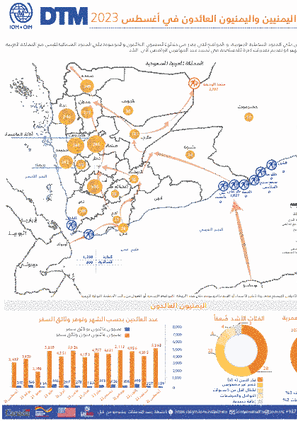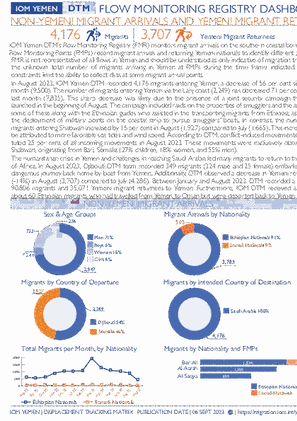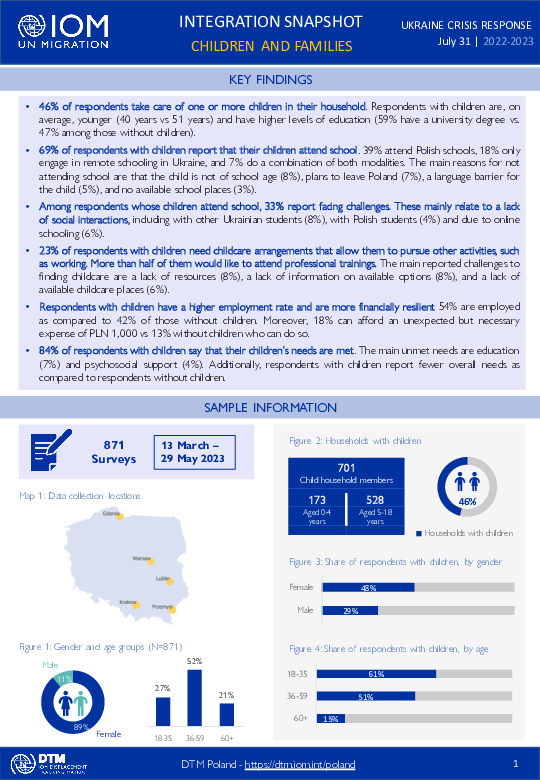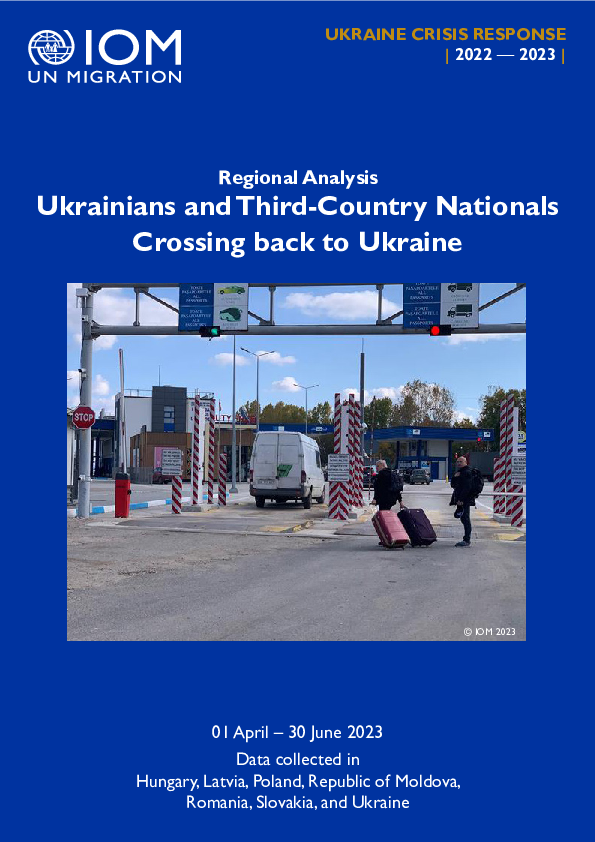-
Countries
-
Data and Analysis
-
Special Focus
-
Crisis Responses

Contact
dtmhaiti@iom.int
Language
English
Location
Haiti
Period Covered
Sep 03 2023
Sep 04 2023
Activity
- Mobility Tracking
- Event Tracking
Armed violence erupted since 12 August 2023 in the neighborhoods of Carrefour-Feuilles and Savanes Pistaches, located in the municipality of Port-au-Prince (West Department) and caused the displacement of thousands of people. Several people fled to relatives in and outside the Metropolitan Area of Port-au-Prince and others took refuge in spontaneous sites. This report presents an update on the number of people hosted in these sites as of 04 September 2023. It should be noted that the security situation remains very volatile in this area, sometimes pushing people to leave sites to seek refuge in others. In some sites where people left, cases of cholera had been reported. People potentially infected with cholera have therefore moved to other sites, increasing the risk of transmission. The follow-up of cholera cases in the sites and preventive measures are crucial at the moment.

Contact
DTM Sudan, DTMSudan@iom.int
Language
English
Location
Sudan
Snapshot Date
Aug 31 2023
Activity
- Mobility Tracking
- Baseline Assessment
Overview
From 15 April 2023, armed clashes erupted between the Sudanese Armed Forces (SAF) and the Rapid Support Forces (RSF) in multiple cities across Sudan. Clashes initially took place in cities across Northern and Khartoum states, later spreading across the Darfur and Kordofan regions.
Highlights
- DTM Sudan estimates that 4,075,930 Individuals (814,518 households) have been recently internally displaced.
- The IDP caseload has been observed in 3,733 locations across all of Sudan’s 18 states.
- The highest proportions of IDPs have been observed in River Nile (12.24%), South Darfur (11.93%), East Darfur (11.47%), Northern (8.93%), Sennar (7.87%), and North Darfur (7.17%).
- Field teams report that the IDPs observed were originally displaced from eight states. The majority (2,820,325 IDPs, 69.19%) have been reportedly displaced from Khartoum state; followed by South Darfur (14.86%), North Darfur (7.99%), Central Darfur (3.71%), West Darfur (3.24%), South Kordofan (0.56%), North Kordofan (0.44%), and Aj Jazirah (0.01%).
- DTM also reports the Mixed Cross-Border Movements of 1,104,360 individuals into neighbouring countries.

Contact
IOM DTM Yemen, iomyemendtm@iom.int
Language
English
Location
Yemen
Period Covered
Aug 01 2023
Aug 31 2023
Activity
- Flow Monitoring
في أغسطس 2023، سجلت مصفوفة تتبع النزوح التابعة للمنظمة الدولية للهجرة في اليمن دخول 4,176 مهاجرًا إلى اليمن، بانخفاض قدره 56 بالمائة منذ الشهر الماضي (9,500). وانخفض عدد المهاجرين الذين يدخلون اليمن عبر ساحل لحج (2,249) بنسبة 71 في المائة منذ الشهر الماضي (7,835). ويعود هذا الانخفاض الحاد على الأرجح إلى وجود حملة أمنية مشتركة انطلقت مطلع شهر آب/أغسطس. وتضمنت الحملة مداهمة ممتلكات المهربين واعتقال بعضهم إلى جانب المرشدين الإثيوبيين الذين ساعدوا في نقل المهاجرين من إثيوبيا، فضلاً عن نشر نقاط عسكرية على الشريط الساحلي لملاحقة قوارب المهربين. وفي المقابل، ارتفع عدد المهاجرين الذين دخلوا شبوة بنسبة 16 بالمائة في أغسطس (1,927) مقارنة بشهر يوليو (1,665). ويمكن أن تعزى هذه الزيادة إلى المد البحري وسرعة الرياح الأكثر ملاءمة. وفقًا لمصفوفة تتبع النزوح، شكلت الحركات الناجمة عن النزاع 25% من جميع الحركات الواردة في أغسطس 2023. وقد لوحظت هذه الحركات حصريًا في شبوة، مصدرها باري بالصومال (27% أطفال، 18% نساء، و55% رجال).
أدت الأزمة الإنسانية في اليمن وتحديات الوصول إلى المملكة العربية السعودية إلى عودة العديد من المهاجرين إلى القرن الأفريقي. في أغسطس 2023، سجل فريق مصفوفة تتبع النزوح في جيبوتي 349 مهاجرًا (324 ذكرًا و25 أنثى) انطلقوا في رحلة خطيرة للعودة إلى وطنهم بالقارب من اليمن. بالإضافة إلى ذلك، لاحظت مصفوفة تتبع النزوح انخفاضًا في عدد العائدين اليمنيين (-14%) في أغسطس (3,707) مقارنة بشهر يوليو (4,286). بين يناير وأغسطس 2023، سجلت مصفوفة تتبع النزوح إجمالي 90,806 مهاجرًا و35,071 مهاجرًا يمنيًا عائدًا إلى اليمن. علاوة على ذلك، تلقت مصفوفة تتبع النزوح التابعة للمنظمة الدولية للهجرة تقريرًا عن 60 مهاجرًا إثيوبيًا سافروا من اليمن إلى عمان ولكن تم ترحيلهم إلى اليمن.
DTM Europe gathers, validates and disseminates information on migrants and refugees travelling through the Mediterranean, Western African Atlantic, and Western Balkan routes to Europe. Key routes include:
- Eastern Mediterranean route (EMR): Bulgaria, Cyprus and Greece
- Central Mediterranean route (CMR): Italy and Malta
- Western Mediterranean route (WMR): Peninsular Coasts of Spain, Balearic Islands, Ceuta and Melilla
- Western African Atlantic route (WAAR): Canary Islands of Spain
DTM also monitors data on migrants in transit through the Western Balkans (WB) region (Albania, Bosnia and Herzegovina, Croatia, Montenegro, North Macedonia, Serbia, Slovenia, Romania, and Kosovo*). These are considered separately to prevent to the extent possible the double counting of the same persons that cross multiple borders to reach Central Europe.
This report presents the latest available data and trends, focusing on the first two quarters of 2023:
- Mixed Migration Flows to Europe
- Migrant Flows Monitoring in the Republic of Türkiye
- First Arrival countries (Italy, Greece, Spain) and other countries of first arrival (Bulgaria, Cyprus and Malta)
- Transits through the Western Balkan region
- Migrants' presence, in Europe and the Republic of Türkiye

Contact
IOM DTM Yemen, iomyemendtm@iom.int
Language
English
Location
Yemen
Period Covered
Aug 01 2023
Aug 31 2023
Activity
- Flow Monitoring
In August 2023, IOM Yemen DTM recorded 4,176 migrants entering Yemen, a decrease of 56 per cent since last month (9,500). The number of migrants entering Yemen via the Lahj coast (2,249) has decreased 71 per cent since last month (7,835). This sharp decrease was likely due to the presence of a joint security campaign that was launched in the beginning of August. The campaign included raids on the properties of smugglers and the arrest of some of these along with the Ethiopian guides who assisted in the transporting migrants from Ethiopia, as well as the deployment of military points on the coastal strip to pursue smugglers' boats. In contrast, the number of migrants entering Shabwah increased by 16 per cent in August (1,927) compared to July (1,665). This increase can be attributed to more favorable sea tides and wind speed. According to DTM, conflict-induced movements constituted 25 per cent of all incoming movements in August 2023. These movements were exclusively observed in Shabwah, originating from Bari, Somalia (27% children, 18% women, and 55% men).
The humanitarian crisis in Yemen and challenges in reaching Saudi Arabia led many migrants to return to the Horn of Africa. In August 2023, Djibouti DTM team recorded 349 migrants (324 male and 25 female) embarked on a dangerous journey back home by boat from Yemen. Additionally, DTM observed a decrease in Yemeni returnees (-14%) in August (3,707) compared to July (4,286). Between January and August 2023, DTM recorded a total of 90,806 migrants and 35,071 Yemeni migrant returnees to Yemen. Furthermore, IOM DTM received a report about 60 Ethiopian migrants who had travelled from Yemen to Oman but were deported back to Yemen.
Contact
Location
Yemen
Activity
- Flow Monitoring
Period Covered
Aug 01 2023 -Aug 31 2023
In August 2023, IOM Yemen DTM recorded 4,176 migrants entering Yemen, a decrease of 56 per cent since last month (9,500). The number of migrants entering Yemen via the Lahj coast (2,249) has decreased 71 per cent since last month (7,835). This sharp decrease was likely due to the presence of a joint security campaign that was launched in the beginning of August. The campaign included raids on the properties of smugglers and the arrest of some of these along with the Ethiopian guides who assisted in the transporting migrants from Ethiopia, as well as the deployment of military points on the coastal strip to pursue smugglers' boats. In contrast, the number of migrants entering Shabwah increased by 16 per cent in August (1,927) compared to July (1,665). This increase can be attributed to more favorable sea tides and wind speed. According to DTM, conflict-induced movements constituted 25 per cent of all incoming movements in August 2023. These movements were exclusively observed in Shabwah, originating from Bari, Somalia (27% children, 18% women, and 55% men).
The humanitarian crisis in Yemen and challenges in reaching Saudi Arabia led many migrants to return to the Horn of Africa.
In August 2023, Djibouti DTM team recorded 349 migrants (324 male and 25 female) embarked on a dangerous journey back home by boat from Yemen. Additionally, DTM observed a decrease in Yemeni returnees (-14%) in August (3,707) compared to July (4,286). Between January and August 2023, DTM recorded a total of 90,806 migrants and 35,071 Yemeni migrant returnees to Yemen. Furthermore, IOM DTM received a report about 60 Ethiopian migrants who had travelled from Yemen to Oman but were deported back to Yemen.
Population Groups
Survey Methodology
Unit of Analysis Or Observation
Type of Survey or Assessment
Keywords
Geographical Scope
Administrative boundaries with available data
The current dataset covers the following administrative boundaries
Flow Monitoring is a component of DTM and it is used to track population movements inside a country, within a region or across regions.
Population Groups
Migrants Present
Other
Refugees/Asylum Seekers
Survey Methodology
Unit of Analysis Or Observation
Individual
Type of Survey or Assessment
Keywords
Since March 2022, IOM Displacement Tracking Matrix (DTM) regularly collects individual surveys in countries neighbouring to Ukraine with persons who cross back, with the aim to improve the understanding of their profiles, displacement patterns, intentions and needs. The survey is deployed in 5 countries neighbouring Ukraine – Hungary, Poland, the Republic of Moldova, Romania, and Slovakia.
Key Findings
- Between April and June 2023, there are more “short-time visitors” (47%) than “prospective returnees” (42%) among Ukrainians crossing back from neighbouring countries, while a minority (11%) is unsure on the length of their visit. Women (91% of the sample) more frequently intend to pay a short visit than men (47% vs 42%). Prospective returnees are older than short-time visitors by 8 years on average (47 years versus 39 years old).
- For both, short-time visitors and prospective returnees, reasons related to the desire to visit or reunite with family members are prevalent. Moreover, one third of short-time visitors mentioned the need to go to the doctor’s, have a surgery or take a specialist exam, and another third aimed at obtaining or renewing identity documents (biometric passport, diplomas, licenses).
- 52% of Ukrainians interviewed stayed in one of the neighbouring countries, for an average period of 10 months before crossing back. The rest stayed mainly in Germany, Czechia, and the UK.
- The period since initial displacement is longer for short-time visitors (407 days), who also have already crossed in and out of Ukraine twice or more since February 2022 in most cases (54%). Prospective returnees (220 days) have spent less time abroad on average and have less frequently travelled in and out of Ukraine before returning than short-time visitors (55% only once or zero).
- The Top 5 needs are: financial support (20%), health support (17%), medicines (12%), food supply (11%) and general information (10%). Short-time visitors report a higher level of needs overall (linked to issues that they aimed to solve during the visit in Ukraine) than prospective returnees. The latter report no needs in more than half (55%) of the cases, as they may be already more focused on the conditions of return rather than on what was not achieved successfully abroad.
- Ukrainians, transiting from Latvia through the Russian Federation to reach eastern areas of Ukraine have a different profile than those crossing from neighbouring countries into western Ukraine. Most originate from areas which are temporary not under Ukraine’s government control in four oblasts – Donetska, Luhanska, Khersonska and Zaporizka. Among them, there are more prospective returnees than short-time visitors, with the desire to reunite with their family members, and with a widespread need of more information about Ukraine and recent developments on the grounds than anything else.
- TCNs have often spent in Ukraine long periods (even more than 5 years) before being displaced abroad because of the military invasion. Most of those interviewed when crossing back from neighbouring countries plan to resume their studies or take exams to avoid interruption of their education cycle and career.
- The profiles and needs expressed by Ukrainians crossing back from neighbouring countries and surveyed between April and June 2023 mostly match with those of the actual returnees from abroad surveyed in Ukraine in May 2023.
- Trends in terms of profiles, intentions and needs from Ukrainians crossing back from between April and June 2023 are in line with what observed in the previous reporting period (January-March 2023), with small variations (+/-2%) between the two consecutive periods on the main quantitative findings

Contact
DTM Europe, DTMMediterranean@iom.int
Language
English
Location
Poland
Period Covered
Mar 13 2023
May 29 2023
Activity
- Survey
Key Findings:
• 46% of respondents take care of one or more children in their household. Respondents with children are, on average, younger (40 years vs 51 years) and have higher levels of education (59% have a university degree vs. 47% among those without children).
• 69% of respondents with children report that their children attend school. 39% attend Polish schools, 18% only engage in remote schooling in Ukraine, and 7% do a combination of both modalities. The main reasons for not attending school are that the child is not of school age (8%), plans to leave Poland (7%), a language barrier for the child (5%), and no available school places (3%).
• Among respondents whose children attend school, 33% report facing challenges. These mainly relate to a lack of social interactions, including with other Ukrainian students (8%), with Polish students (4%) and due to online schooling (6%).
• 23% of respondents with children need childcare arrangements that allow them to pursue other activities, such as working. More than half of them would like to attend professional trainings. The main reported challenges to finding childcare are a lack of resources (8%), a lack of information on available options (8%), and a lack of available childcare places (6%).
• Respondents with children have a higher employment rate and are more financially resilient 54% are employed as compared to 42% of those without children. Moreover, 18% can afford an unexpected but necessary expense of PLN 1,000 vs 13% without children who can do so.
• 84% of respondents with children say that their children’s needs are met. The main unmet needs are education (7%) and psychosocial support (4%). Additionally, respondents with children report fewer overall needs as compared to respondents without children.
Contact
DTM Sudan, DTMSudan@iom.int
Location
Sudan
Activity
- Mobility Tracking
- Baseline Assessment
Period Covered
May 19 2023 -Aug 27 2023
From 15 April 2023, armed clashes erupted between the Sudanese Armed Forces (SAF) and the Rapid Support Forces (RSF). As a result of the military clashes, DTM Sudan estimates that 3,801,754 Individuals (759,651 Households) have been recently internally displaced. The IDP caseload has been observed in all of Sudan’s in 3,428 locations across all of Sudan’s 18 states.1 The highest proportions of IDPs have been observed in River Nile (13.47%), East Darfur (10.39%), Northern (9.58%), South Darfur (8.42%), Sennar (7.67%), and White Nile (7.49%).
Field teams report that the IDPs observed were originally displaced from eight states, the majority (2,766,600 IDPs, 72.77%) have been reportedly displaced from Khartoum state; followed by North Darfur (7.63%), South Darfur (9.39%), West Darfur (3.52%), Central Darfur (4.93%), North Kordofan (0.45%), South Kordofan (1.30%), and Aj Jazirah (0.01%). DTM Sudan also estimates that approximately 2.84% of the IDP caseload are non-Sudanese nationals. In addition to the internal displacement, the con ict in Sudan has caused the Mixed Cross-Border Movements of 1,072,804 individuals into neighbouring countries namely Egypt, Libya, Chad, Central African Republic, South Sudan and Ethiopia. 67% of arrivals tracked in those countries were Sudanese nationals and 33% estimated foreign nationals and returnees. The majority of arrivals were reported in Chad (41.4%), Egypt (26.6%),3 and South Sudan (22.7%).
Population Groups
Survey Methodology
Unit of Analysis Or Observation
Type of Survey or Assessment
Keywords
Geographical Scope
Administrative boundaries with available data
The current dataset covers the following administrative boundaries

